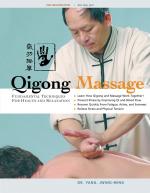When you sprain an ankle or injure any other joint, you automatically rub and feel the joint with your hands. When you feel discomfort in your stomach or any other internal organ, you may rub it gently with your hand, and soon the discomfort goes away. All of these are examples of using self-massage to improve the Qi and blood circulation in an area where pain or discomfort is felt, in order to lessen the discomfort. Listening to these signals from your body is important. Remember, feeling is the language between the mind and body. Self-massage is a vital but often overlooked aspect of a complete Qigong practice.
Let us consider some other examples. When your neck or back is stiff what is your natural reaction? In the case of your neck, you will move your head in a circle or side to side to relax it. Similarly, when your back is stiff, you flex your back, twist it from side to side, or stretch it by bending forward. What do you do when you feel discomfort in the area of your solar plexus—or tension in any other internal organ—caused by being in an improper posture for a long time, such as sitting in front of a computer? Your natural reaction is to stand up and stretch your arms while taking a few deep breaths, and sometimes you will move your body around or move your waist in a circle a few times. All of these actions release tension and let you feel comfortable again.
If you understand these natural human reactions, then you can easily understand what self-massage is. We can therefore define self-massage as using the hands to rub the body, or using body movement, to release tension in the body or internal organs by improving the Qi and blood circulation.
The highest level of massage is Chinese Qigong massage, which uses Qi manipulation rather than purely physical massage. However, this cannot be done unless you have had Qigong training. In Qi self-massage, the Qigong practitioner is able to use their mind to release the tension or pressure in tensed areas. He or she can also use the mind to circulate Qi in that area in order to speed up the healing process. The theory behind this is very simple. Your entire body (which includes both your Qi body and your physical body) is governed by your mind. Originally, we were able to use our minds to lead Qi to every part of the body to cause it to move. However, through the many years of ‘civilized’ living we have gradually lost the instinct for this mind-body control, which most other animals still have. Through proper practice, we can regain this mind-body correspondence. In fact, this is the basic theory of all Chinese Qigong practice returning to the natural way (Dao). This is the "Gongfu of Internal Vision", and like any other skill, it can be cultivated.
In Part 2, we will try to understand the deeper purposes and theory of self Qigong Massage.
The subject of self-massage is instructed in depth in the book "Qigong Massage" and the "Qigong Massage DVD".




